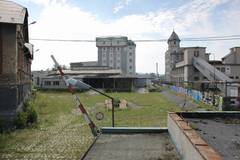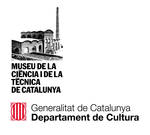07 October 2013
"Business Models for Creative Cooperation", a follow-up perspective from the last workshop

Svetovar brewery site where the CreativeCH workshop took place in the building shown in the centre of image. Image kindly provided by Pilsen2015.
The workshop Business Models for Creative Cooperation was held in Pilsen (Czech Republic) on the 17 September this year as part of the Pilsen Week of Culture Factory [Download the programme here].
It took place at the former Svetovar brewery site and focused on the opportunities and challenges in the revitalization and communication of such industrial heritage sites. Revitalization involves adapted new uses of such sites often in the form of facilities for cultural organizations (museums, galleries, etc.) and workspaces for creative industry businesses.
The workshop presented and discussed approaches for creative cooperation of site developers, creative businesses, science & technology centers and cultural heritage organizations. The participants comprised organizers of Pilsen2015, managers of Rote Fabrik Zurich (Switzerland), CreativeCH partners, speakers from Austria, Germany, Netherlands, Portugal and Spain, and members of the local community. This community included managers of cultural facilities, artists and young professionals working on cultural projects.
After an opening address by Joaquim Carvalho (University of Coimbra), three presentations were given in the first session of the workshop:
Laurie Neale – architect, heritage consultant and Europa Nostra Council member – presented several private/public partnership models used successfully for financing industrial heritage regeneration projects. Novel funding mechanisms, such as the Dutch BankGiro Lottery grants or “crowd sourcing” of financial contributions caught the attention of participants and other speakers.
Heike Oevermann (Georg-Simmel-Zentrum für Metropolenforschung, Humboldt-Universität Berlin) presented three cases of industrial heritage sites in the context of urban transformation: the Sulzer Areal in Winterthur, the Liverpool waterfront, and the industrial complex of Zeche Zollverein, Essen. Oevermann addressed positive aspects of the revitalization of industrial sites, but also conflicts among the various stakeholders who have different values and goals. Therefore she highlighted some “bridging values” that provide a basis for collaboration, for example, the historical character of industrial heritage buildings which is valued both by developers and users.
Based on the experiences and recent projects of the Institut für Neue Industriekultur (INIK), Lars Scharnholz explained re-use opportunities and challenges of industrial heritage sites located in German-Polish border areas. He pointed out the greater challenges these areas face in comparison to dynamic large cities. In particular he emphasized that projects of young people that explore creative uses of sites raise awareness of their value and, thereby, help to protect them from degradation.
In the second session of the workshop, Jörn Harfst, research associate at the Karl Franzens University of Graz, described experiences from European projects on the creative valorization of industrial heritage sites. He presented the SHIFT-X project which promotes the use of former industrial sites for economic revitalization in regions with small to medium-sized towns. Harfst pointed out opportunities and challenges of European projects, which included new networking and funding mechanisms, but also that there is no “one size fits all” solution because of the different situations the European regions present.
Joana Branco Gomes followed with a presentation of the Lisbon LX Factory, an example of successful re-use of a large site in the heart of Lisbon. The site was re-vitalized by MainSide, a company that specializes in urban real estate investments and regeneration. The LX Factory offers spaces and services for various small companies and cultural organisations that value the synergies among each other and the inspiring atmosphere of the site.
Eusebi Casanelles, former Director of mNACTEC and Life President of the International Committee for the Conservation of the Industrial Heritage (TICCIH), analyzed the case of the Poblenou district in Barcelona. Facing the transformation of their district by rapid urban development, the inhabitants stood up and requested preservation of areas and buildings they value. This promoted preservation and re-use in the context of a considerable transformation of the district overall.
After each of the two sessions a moderated discussion addressed specific issues. For example, this included how to forge public-private partnerships, the roles of civic, cultural and artistic associations in the revitalization of sites, how to involve the larger public, and so forth. A special focus was on business models and how to transfer and stimulate the uptake of good practices and new creative ideas in the revitalization and communication of industrial heritage sites.
The workshop was hosted by Pilsen Week of Culture Factory, which took place from 16 to 20 September 2013. The event comprised a series of seminars, workshops and exhibitions devoted to the re-use of former industrial sites for activities in the spheres of culture, art and community life. It drew experts from outside the Czech Republic who have experience with running cultural centres, such as the future Culture Factory in Svetovar, which was the main venue of the event. The programme culminated in an international conference on 19 September, which brought together experts in industrial heritage, architects, urban design, policy makers and the interested public.
Business Models for Creative Cooperation
CreativeCH video of the workshop in Pilsen (CZ), 17.09.2013. Produced by MFG Innovation, published on YouTube (04.10.2013), http://youtu.be/bjOponEdSkg
back






